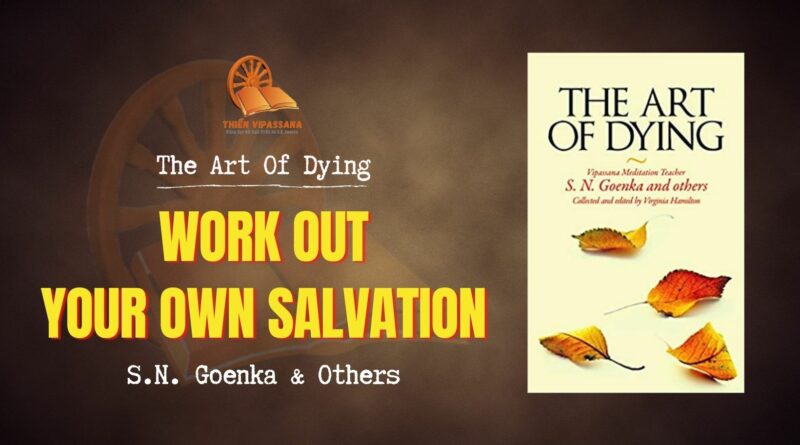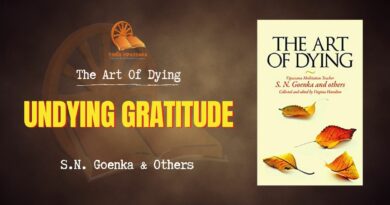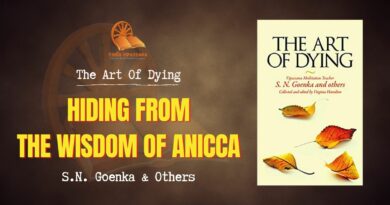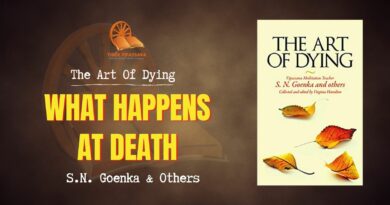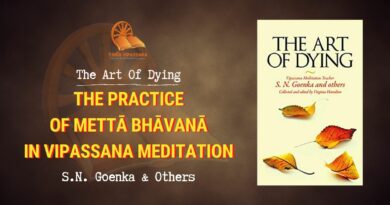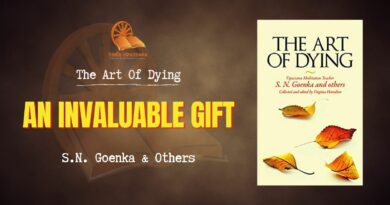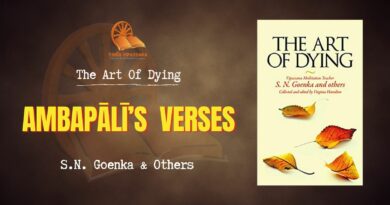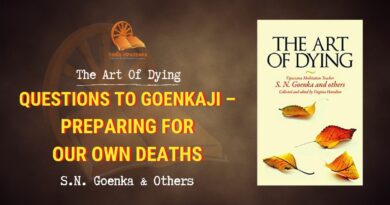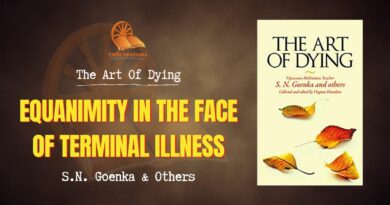Work Out Your Own Salvation
As we practice daily, morning and evening, Vipassana stays alive within us. The awareness of bodily sensations, our early warning system, alerts us to reactions that keep reinforcing our unwholesome habits. As we work to change this pattern, the need to become masters of our minds becomes crystal clear.
The process is simple, but subtle. It is easy to slip, and an uncorrected divergence can continue to widen because the path is exceedingly long. Therefore, as opportunity permits, it is good to review the correct way to practice through sitting courses and listening carefully to Goenkaji’s elucidating discourses.
This article, which appeared in the spring 1997 issue of the Vipassana Newsletter, is an abridgement of a discourse given by Goenkaji on the second day of a three-day course for experienced students. Here he carefully reviews the technique of Vipassana, explaining the practice in detail.
At the surface, the mind plays so many games—thinking, imagining, dreaming, giving suggestions. But deep inside the mind remains a prisoner of its own habit pattern; and the habit pattern at the deepest level of the mind is to feel sensations and react. If the sensations are pleasant, the mind reacts with craving. If they are unpleasant, it reacts with aversion.
The enlightenment of the Buddha was to go to the root of the problem. Unless we work at the root level, we shall be dealing only with the intellect and only this part of the mind will be purified. As long as the roots of a tree are unhealthy, the whole tree will be sick. If the roots are healthy, then they will provide healthy sap for the entire tree. So start working with the roots— this was the enlightenment of the Buddha.
When he gave Dhamma, the path of morality, concentration and wisdom (sīla, samādhi and paññā), it was not to establish a cult, a dogma, or a belief. The Noble Eightfold Path is a practical path and those who walk on it can go to the deepest level of the mind and eradicate all their miseries.
Those who have really liberated themselves know that going to the depth of the mind—making a surgical operation of the mind—has to be done by oneself, by each individual. Someone can guide you with love and compassion; someone can help you on your journey along the path. But nobody can carry you on his shoulders, saying, “I will take you to the final goal. Just surrender to me. I will do everything.”
You are responsible for your own bondage. You are responsible for making your mind impure—no one else. Only you are responsible for purifying your mind, for breaking the bonds.
Continuity of practice is the secret of success. When it is said that you should be continuously aware, it means that you must be aware with wisdom of sensations in the body, where you really experience things arising and passing away. This awareness of impermanence is what purifies your mind—the awareness of the sensations arising, passing.
Intellectualizing this truth will not help. You may understand: “Everything that arises sooner or later passes away. Anyone who takes birth sooner or later dies. This is anicca.” You might understand this correctly but you are not experiencing it. It is your own personal experience that will help you purify your mind and liberate you from your miseries. The word for “experience” used in India at the time of the Buddha was vedanā, feeling by experiencing, not just by intellectualization. And this is possible only when sensations are felt in the body.
Anicca must be experienced. If you are not experiencing it, it is merely a theory, and the Buddha was not interested in theories. Even before the Buddha, and at the time of the Buddha, there were teachers who taught that the entire universe is in flux, anicca—this was not new. What was new from the Buddha was the experience of anicca; and when you experience it within the framework of your own body, you have started working at the deepest level of your mind.
Two things are very important for those who walk on the path. The first is breaking the barrier that divides the conscious and the unconscious mind. But even if your conscious mind can now feel those sensations that were previously felt only by the deep unconscious part of your mind, that alone will not help you.
The Buddha wanted you to take a second step: change the mind’s habit of reacting at the deepest level.
Coming to the stage where you have started feeling sensations is a good first step, yet the habit pattern of reaction remains. When you feel an unpleasant sensation, if you keep reacting—“Oh, I must get rid of this”—that won’t help. If you start feeling a pleasant flow of very subtle vibrations throughout the body, and you react—“Ah, wonderful! This is what I was looking for. Now I’ve got it!”—you have not understood Vipassana at all.
Vipassana is not a game of pleasure and pain. You have been reacting like this your entire life, for countless lifetimes. Now in the name of Vipassana you have started making this pattern stronger. Every time you feel an unpleasant sensation you react in the same way, with aversion. Every time you feel pleasant sensation you react in the same way, with craving. Vipassana has not helped you because you have not helped Vipassana.
Whenever you again make the mistake of reacting because of the old habit, see how quickly you become aware of it: “Look— an unpleasant sensation and I am reacting with aversion; a pleasant sensation and I am reacting with craving. This is not Vipassana. This will not help me.”
Understand, this is what you have to do. If you are not 100 percent successful, it doesn’t matter. This won’t harm you as long as you keep understanding and keep trying to change the old habit pattern. If for even a few moments you have started coming out of your prison, then you are progressing.
This is what the Buddha wanted you to do: practice the Noble Eightfold Path. Practice sīla so that you can have the right type of samādhi. For those who keep breaking sīla, there is little hope that they will go to the deepest levels of reality. Sīla develops after you have some control over your mind, after you start understanding with paññā that breaking sīla is very harmful. Your paññā at the experiential level will help your samādhi. Your samādhi at the experiential level will help your sīla. Your stronger sīla will help your samādhi become strong. Your stronger samādhi will help your paññā become strong. Each of the three will help the other two, and you will keep progressing.
You must be with reality, with the truth as it is. Things keep changing. All vibrations are nothing but a flux, a flow. This realization removes the deep-rooted habit pattern of reacting to the sensations.
Whatever sensations you experience—pleasant, unpleasant or neutral—you should use them as tools. These sensations can become tools to liberate you from your misery, provided you understand the truth as it is. But these same sensations can also become tools that multiply your misery. Likes and dislikes should not cloud the issue. The reality is: sensations are arising and passing away; they are anicca. Pleasant, unpleasant or neutral—it makes no difference. When you start realizing the fact that even the most pleasant sensations you experience are dukkha (suffering), then you are coming nearer to liberation.
Understand why pleasant sensations are dukkha. Every time a pleasant sensation arises, you start relishing it. This habit of clinging to pleasant sensations has persisted for countless lifetimes. And it is because of this that you have aversion. Craving and aversion are two sides of the same coin. The stronger the craving, the stronger the aversion is bound to be. Sooner or later every pleasant sensation turns into an unpleasant one, and every unpleasant sensation will turn into a pleasant one—this is the law of nature. If you start craving pleasant sensations, you are inviting misery.
The Buddha’s teaching helps us to disintegrate the solidified intensity that keeps us from seeing the real truth. In reality, there are mere vibrations, nothing else. At the same time, there is solidity. For example, this wall is solid. This is a truth, an apparent truth. The ultimate truth is that what you call a wall is nothing but a mass of vibrating subatomic particles. We have to integrate both truths through proper understanding.
Dhamma develops our understanding, so that we free ourselves from the habit of reacting and recognize that craving is harming us, hating is harming us. Then we are more realistic: “See, there is ultimate truth, and there is apparent truth, which is also a truth.”
The process of going to the depth of the mind to liberate yourself has to be done by you alone, but you must also be prepared to work with your family, with society as a whole. The yardstick to measure whether love, compassion, and good will are truly developing is whether these qualities are being exhibited toward the people around you.
The Buddha wanted us to be liberated at the deepest level of our minds. And that is possible only when three characteristics are realized: anicca (impermanence), dukkha (suffering), and anattā (egolessness). When the mind starts to become free from conditioning, layer after layer becomes purified until the mind is totally unconditioned. Purity then becomes a way of life. You won’t have to practice mettā (compassionate love) as you do now at the end of your one-hour sitting. Later, mettā just becomes your life. All the time you will remain suffused with love, compassion, and good will. This is the aim, the goal.
The path of liberation is the path of working at the deepest level of the mind. There is nothing wrong with giving good mental suggestions, but unless you change the blind habit of reacting at the deepest level, you are not liberated. Nobody is liberated unless the deepest level of the mind is changed, and the deepest level of the mind is constantly in contact with bodily sensations.
We have to divide, dissect, and disintegrate the entire structure to understand how mind and matter are so interrelated. If you work only with the mind and forget the body, you are not practicing the Buddha’s teaching. If you work only with the body and forget the mind, again you do not properly understand the Buddha.
Anything that arises in the mind turns into matter, into a sensation in the material field. This was the Buddha’s discovery. People forgot this truth, which can only be understood through proper practice. The Buddha said, “Sabbe dhammā vedanā samosaraṇā”—“Anything that arises in the mind starts flowing as a sensation on the body.”
The Buddha used the word āsava, which means flow or intoxication. Suppose you have generated anger. A biochemical flow starts that generates very unpleasant sensations. Because of these unpleasant sensations, you start reacting with anger. As you generate anger, the flow becomes stronger. There are unpleasant sensations and, with them, a biochemical secretion.
As you generate more anger, the flow becomes stronger.
In the same way, when passion or fear arises, a particular type of biochemical substance starts flowing in the blood. A vicious circle starts that keeps repeating itself. There is a flow, an intoxication, at the depth of the mind. Out of ignorance we get intoxicated by this particular biochemical flow. Although it makes us miserable, yet we are intoxicated; we want it again and again. So we keep on generating anger upon anger, passion upon passion, and fear upon fear. We become intoxicated by whatever impurity we generate in our minds. If we say that someone is addicted to alcohol or drugs, this is actually untrue. No one is addicted to alcohol or drugs. The truth is that one is addicted to the sensations that are produced by the alcohol or drugs.
The Buddha teaches us to observe reality. Every addiction will be undone if we observe the truth of sensations in the body with this understanding: “Anicca, anicca. This is impermanent.” Gradually we will learn to stop reacting.
Dhamma is so simple, so scientific, so true—a law of nature applicable to everyone. Buddhist, Hindu, Muslim, Christian; American, Indian, Burmese, Russian, or Italian—it makes no difference; a human being is a human being. Dhamma is a pure science of mind, matter, and the interaction between the two. Don’t allow it to become a sectarian or philosophical belief. This will be of no help
The greatest scientist the world has produced worked to find the truth about the relationship between mind and matter. And discovering this truth, he found a way to go beyond mind and matter. He explored reality not for the sake of curiosity but to find a way to be free of suffering. For every individual there is so much misery—for every family, for every society, for every nation, for the entire world—so much misery. The Enlightened One found a way to be free of this misery.
Each individual has to come out of misery. There is no other solution. Every member of a family must come out of misery. Then the family will become happy, peaceful, and harmonious. If every member of society comes out of misery, if every member of a nation comes out of misery, if every citizen of the world comes out of misery, only then will there be world peace.
There can’t be world peace just because we want world peace—“I am agitating for world peace; therefore it should occur.” This doesn’t happen. We can’t agitate for peace. When we are agitated, we lose our own peacefulness. So, no agitation! Purify your mind; then every action you take will add peace to the universe.
Purify your mind. This is how you can help society; this is how you can stop harming others and start helping them. When you work for your own liberation, you will find that you have also started helping others to come out of their misery. One individual becomes several individuals—a slow widening of the circle. There is no magic, no miracle. Work for your own peace, and you will find that you have started making the atmosphere around you more peaceful—provided you work properly.
If there is any miracle, it is the miracle of changing the habit pattern of the mind from rolling in misery to freedom from misery. There can be no bigger miracle than this. Every step taken toward this kind of miracle is a healthy step, a helpful step. Any other apparent miracle is bondage.
May you all come out of your misery and become free of your bondage. Enjoy real peace, real harmony, real happiness.
—S.N. Goenka
Aciraṃ vatayaṃ kāyo,
pathaviṃ adhisessati;
Chuddho apetaviññāṇo,
niratthaṃva kaliṅgaraṃ.
Alas! Ere long this corporeal body will lie flat upon the earth, unheeded, devoid of consciousness, like a useless log of wood.
—Dhammapada 3.41
Bài viết này được trích từ cuốn sách The Art of Dying – Thiền Sư S.N.Goenka và nhiều tác giả khác.

